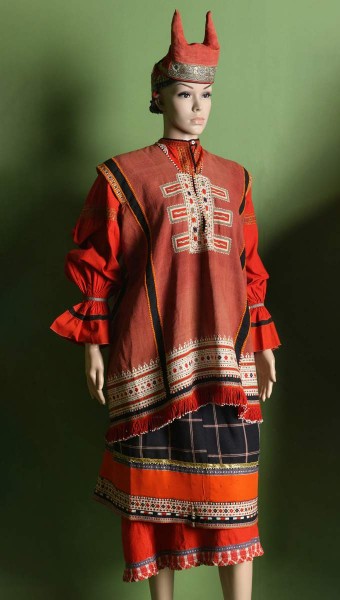Female Festive Costume
Epifan District (?), Tula Gubernia. 19th century
- Red calico, braid, spangles, russian lace, wool, linen, fringe, beads, double-sided cross stitching, cotton, passementerie, fabric, бумажная ткань, metal thread, вышивка в прикреп, крест, косичка, gold embroidery
- В-7073; В-7071; В-7072; В-3039
Shirt
Red calico, braid, spangles, Russian lace
Sleeveless Jacket
Wool, flax, spangles, fringe, beads, double-sided cross stitching
Ponyova
Wool, flax, cotton, passementerie, spangles, beads, double-sided cross stitching
Headdress ‑ Horned Kichka
Fabric
A horned headdress, connected to the idea of fertility, was of particular significance to farmers, and spectacular examples of the horned headdress featured in national costume throughout the entire period, even though the church objected to headwear such as the kichka for a long time. The persistence of horns in headdress was due to the echoes of an ancient belief in magic, encouraged by peasant ideas and passed down through families.
Pozatylen (back part of a headdress)
Gold embroidery, beads
A unique ensemble of festive costume that includes a sleeveless jacket decorated with beads, silk fringe and black vertical stripes. The ponyova is embellished with the same beaded design. The lower edge of the shirt is decorated with Russian lace: colored Mikhailov lace was made in the neighboring gubernia of Ryazan. Residents of many neighboring regions used it in their costume.

